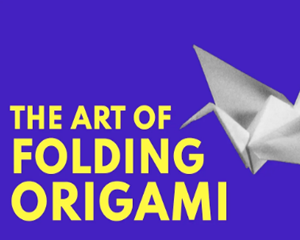As the space telescope prepares to snap a photo, the light of the nearby star blocks its view.
当太空望远镜准备拍照时,附近恒星的光线挡住了视线。
But the telescope has a trick up its sleeve: a massive shield to block the glare.
但望远镜自有妙招:用一个巨大遮星板来遮挡眩光。
This starshade has a diameter of about 35 meters -- that folds down to just under 2.5 meters, small enough to carry on the end of a rocket.
这个遮星板直径大约35米--折叠起来则不到2.5米,小到可以放在火箭的末端。
Its compact design is based on an ancient art form.
其紧凑设计基于一种古老艺术形式。
Origami, which literally translates to "folding paper," is a Japanese practice dating back to at least the 17th century.
折纸,字面意思是折叠纸张,是至少可以追溯到十七世纪日本的一种做法。
In origami, the same simple concepts yield everything from a paper crane with about 20 steps, to this dragon with over 1,000 steps, to a starshade.
在折纸中,同样简单的概念可以折成任何的东西:从只需20个步骤的纸鹤到需要1000个步骤的纸龙,甚至可以做成遮星板。
A single, traditionally square sheet of paper can be transformed into almost any shape, purely by folding.
一张传统的方形纸,仅仅通过折叠,就可以变成任何的形状。
Unfold that sheet, and there's a pattern of lines, each of which represents a concave valley fold or a convex mountain fold.
展开那张纸,可以看到线条图案,每条线代表一个凹谷褶皱或者一个凸山褶皱。
Origami artists arrange these folds to create crease patterns, which serve as blueprints for their designs.
折纸艺术家通过折叠去创造折痕,来作为他们设计的蓝图。
Though most origami models are three dimensional, their crease patterns are usually designed to fold flat without introducing any new creases or cutting the paper.
虽然大多数折纸模型都是三维的,折痕图案通常设计为平折,不会引入任何新折痕或切割纸张。
The mathematical rules behind flat-foldable crease patterns are much simpler than those behind 3D crease patterns
平折折痕背后的数学规则比3D折痕图案背后的规则要简单的多,
it's easier to create an abstract 2D design and then shape it into a 3D form.
先创造抽象的2D设计,再塑造成3D会更加简单。
There are four rules that any flat-foldable crease pattern must obey.
任何平折的折痕图案都必须遵守四个规则。
First, the crease pattern must be two-colorable -- meaning the areas between creases can be filled with two colors so that areas of the same color never touch.
首先,折痕的图案必须可涂双色--即折痕间的区域可用两种颜色填充,使相同颜色的区域永远不会接触。
Add another crease here, and the crease pattern no longer displays two-colorability.
在此处添加另一个折痕,折痕图不再显示两种可着色性。

Second, the number of mountain and valley folds at any interior vertex must differ by exactly two
第二条,山和沟褶皱的数量在任何内部顶点必须差恰好两个,
like the three valley folds and one mountain fold that meet here.
就像这里交汇的三谷褶皱和一山褶皱一样。
Here's a closer look at what happens when we make the folds at this vertex.
下面仔细看看在这个顶点进行折叠时会发生什么。
If we add a mountain fold at this vertex, there are three valleys and two mountains.
如果在这个顶点添加一个山褶,就有三个山谷和两个山。
If it's a valley, there are four valleys and one mountain. Either way, the model doesn't fall flat.
如果是谷,则有四谷一山。无论哪种方式,模型都不会平坦。
The third rule is that if we number all the angles at an interior vertex moving clockwise or counterclockwise,
第三条规则是,如果我们对内部顶点处所有角进行编号,顺时针或逆时针标注均可,
the even-numbered angles must add up to 180 degrees, as must the odd-numbered angles.
偶数角加起来必须是180度,奇数角也必须如此。
Looking closer at the folds, we can see why.
仔细观察褶皱,可以看出原因。
If we add a crease and number the new angles at this vertex, the even and odd angles no longer add up to 180 degrees, and the model doesn't fold flat.
如果在这个顶点添加一个折痕并给新的角编号,偶数和奇数角度加起来不再是180度,并且模型不会折叠平。
Finally, a layer cannot penetrate a fold. A 2D, flat-foldable base is often an abstract representation of a final 3D shape.
最后,一层纸不能穿过褶皱。一个可折叠2D平面底座,通常是最终3D形状的抽象表示。
Understanding the relationship between crease patterns, 2D bases, and the final 3D form allows origami artists to design incredibly complex shapes.
了解折痕图案、2D基座和最终3D形式的关系,令折纸艺术家设计出极其复杂的形状。
Take this crease pattern by origami artist Robert J. Lang.
以折纸艺术家Robert J.Lang的折痕图案为例。
The crease pattern allocates areas for a creature's legs, tail, and other appendages.
通过折痕图案分配区域,分出动物的腿、尾巴和其他部位。
When we fold the crease pattern into this flat base, each of these allocated areas becomes a separate flap.
当我们将折痕图案折叠到这个平坦底座上时,这些分好的区域中的每一个都成为一个单独的襟翼。
By narrowing, bending, and sculpting these flaps, the 2D base becomes a 3D scorpion.
通过缩小、弯曲和塑性这些襟翼,2D基底变成了3D蝎子。
Now, what if we wanted to fold 7 of these flowers from the same sheet of paper?
现在,如果我们想在同一张纸上折叠7朵花怎么办?
If we can duplicate the flower's crease pattern and connect each of them in such a way that all four laws are satisfied,
如果我们可以复制花朵的折痕图案,并以满足所有四个定律的方式连接它们中的每一个,
we can create a tessellation, or a repeating pattern of shapes that covers a plane without any gaps or overlaps.
就可以创建一个镶嵌或形状重复,覆盖一个平面,没有任何间隙或重叠。
The ability to fold a large surface into a compact shape has applications from the vastness of space to the microscopic world of our cells.
将大表面折叠成紧凑形状的能力,在广阔的空间和我们细胞的微观世界中都有应用。
Using principles of origami, medical engineers have re-imagined the traditional stent graft, a tube used to open and support damaged blood vessels.
运用折纸原理,医学工程师重新构想了传统的覆膜支架,即一个用于打开和支撑受损血管的管子。
Through tessellation, the rigid tubular structure folds into a compact sheet about half its expanded size.
通过镶嵌,刚性管状结构折叠成紧凑的薄片,体积约是展开后的一半。
Origami principles have been used in airbags, solar arrays, self-folding robots, and even DNA nanostructures -- who knows what possibilities will unfold next.
折纸原理已用于安全气囊、太阳能电池板、自折叠机器人,甚至DNA纳米结构--谁知道接下来会出现什么可能性。


